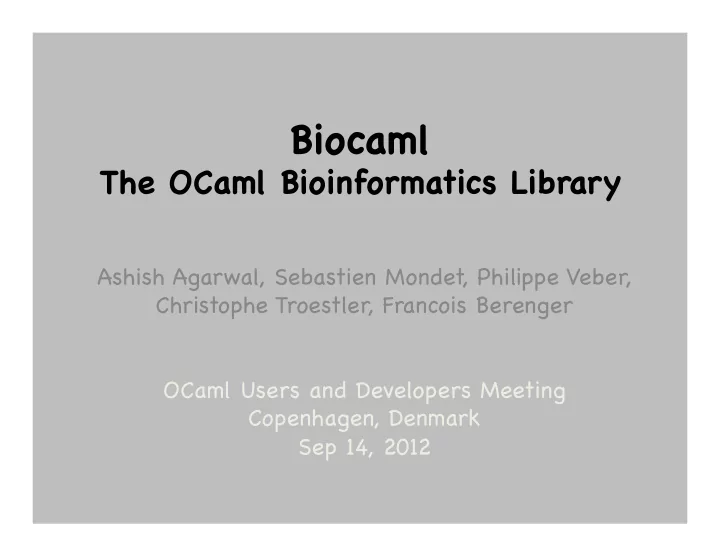

� Biocaml � The OCaml Bioinformatics Library � Ashish Agarwal, Sebastien Mondet, Philippe Veber, � Christophe Troestler, Francois Berenger � OCaml Users and Developers Meeting � Copenhagen, Denmark � Sep 14, 2012 �
DNA – The Code of Life � 2 ¡
DNA Unravelled � 3 ¡
DNA Sub-structrues � 4 ¡
Biocaml: Main Features � • File Formats � • Data structures � • Public data repositories � • … Algorithms � 5 ¡
File Formats � • Currently supported file formats � – bar, bed, bpmap, cel, fasta, fastq, gff, sam, bam, sbml, sgr, ucsc tracks, wig, tsv/csv with column names � 6 ¡
FASTA � 7 ¡
WIG � 8 ¡
GFF � 9 ¡
File Formats: General Features � • Streaming – for big data � • Partial parsing – for speed � • Non-blocking � • Error handling � – explicit in return types � – exceptionful � • Comprehensive documentation � • g(un)zip-able � 10 ¡
Fasta: Types � • type ‘a item = { � header : string; � sequence : ‘a } � • type ‘a raw_item = [ � | `comment of string � | `header of string � | `partial_sequence of `a ] � Speed ups up to 35%. � 11 ¡
Polymorphic Variants for Errors � • type string_to_raw_item = [ � | `empty_line of Pos.t � | `incomplete_input of Pos.t * string list * string option � | `malformed_partial_sequence of Pos.t * string ] � • type raw_item_to_item = [ � | `unnamed_char_seq of char_seq � | `unnamed_int_seq of int_seq ] � • type t = [ � | string_to_raw_item � | raw_item_to_item ] � Precise yet easy-to-provide error information. � 12 ¡
Error Handling � • Strongly typed interface: � in_channel_to_char_seq_item_stream : � in_channel -> � (char_seq, Error.t) Result.t Stream.t � • Exceptionful interface for scripting: � in_channel_to_char_seq_item_stream : � in_channel -> � char_seq Stream.t � 13 ¡
Non-blocking IO � • Lwt or Async? And standard IO � • Our solution: � • Buffered Transforms: (‘a, ‘b) t � • val feed : ('a, 'b) t -> ‘a unit � • val next : ('a, 'b) t -> � [ `end_of_stream | `not_ready | `output of 'b ] � 14 ¡
Affect of Buffer Size � 15 ¡
Legos � • let ( |- ) = Transform.compose � • let parser = � Zip.unzip ~format:`gzip � |- Fasta.string_to_char_seq_raw_item � |- Fasta.char_seq_raw_item_to_item � 16 ¡
Data Structures � • Data structures � – integer interval trees � – sparse integer sets � – maps from integer intervals to ‘a � – efficient polymorphic histograms � 17 ¡
Overlap Query � gene ¡ gene ¡ gene ¡ new ¡finding ¡ 18 ¡
Read Counting � • Given aligned reads, compute read count at each genomic position � 19 ¡
ROC Curve Statistics � Known ¡Genes ¡– ¡Gold ¡Standard ¡ RNA-‑seq ¡experiment ¡ • false positives = bp’ s in new experiment minus those in annotation � • true positives = bp’ s in new experiment and in annotation � • … � 20 ¡
• Annotations are hierarchical � chromosome ¡ gene ¡ mRNA ¡ exon ¡ intron ¡ exon ¡ CDS ¡ 21 ¡
� � Two Partial Orders on Integer Intervals � • Positional � – intervals are to the left or right of each other � – Example 1 � u ¡ v ¡ – Example 2 � u ¡ v ¡ • Containment � – intervals contain or are contained by each other � – Example � u ¡ v ¡ 22 ¡
Sparse Integer Sets (DIET Sets) � • Desired set of integers: � {3, 4, 5, 6, 7, 8, 9, 10, 22, 23, 24, 25, 26} � • Internal representation � [(3,10), (22, 26)] � • Example: intersect � – set1 = [(3,10), (22, 26)] � – set2 = [(8,12), (30, 42)] � – Result: [(8,10)] � 23 ¡
Read Counting � • If input reads are positionally sorted: � – low memory solution possible � – print count for position i when lower bound of current interval > i � • Else: � – need an interval tree with nodes carrying counts � – insert requires merging/splitting nodes � 24 ¡
Public Data Repositories � • Essential to all Biologists � • Submission to public repositories a requirement of publication � • Entrez, GEO, SRA, … � and hundreds more � 25 ¡
GPU Tesla M2070 nodes � 26 ¡
BarraCUDA: Multiple GPUs vs Multiple CPUs � 27 ¡
Conclusions � • All aspects of CS applicable to Bio � • USA: health care costs = 18% of GDP � • Biocaml � – just starting � – your contributions are welcome � – open source � http:/ /biocaml.org � 28 ¡
Recommend
More recommend